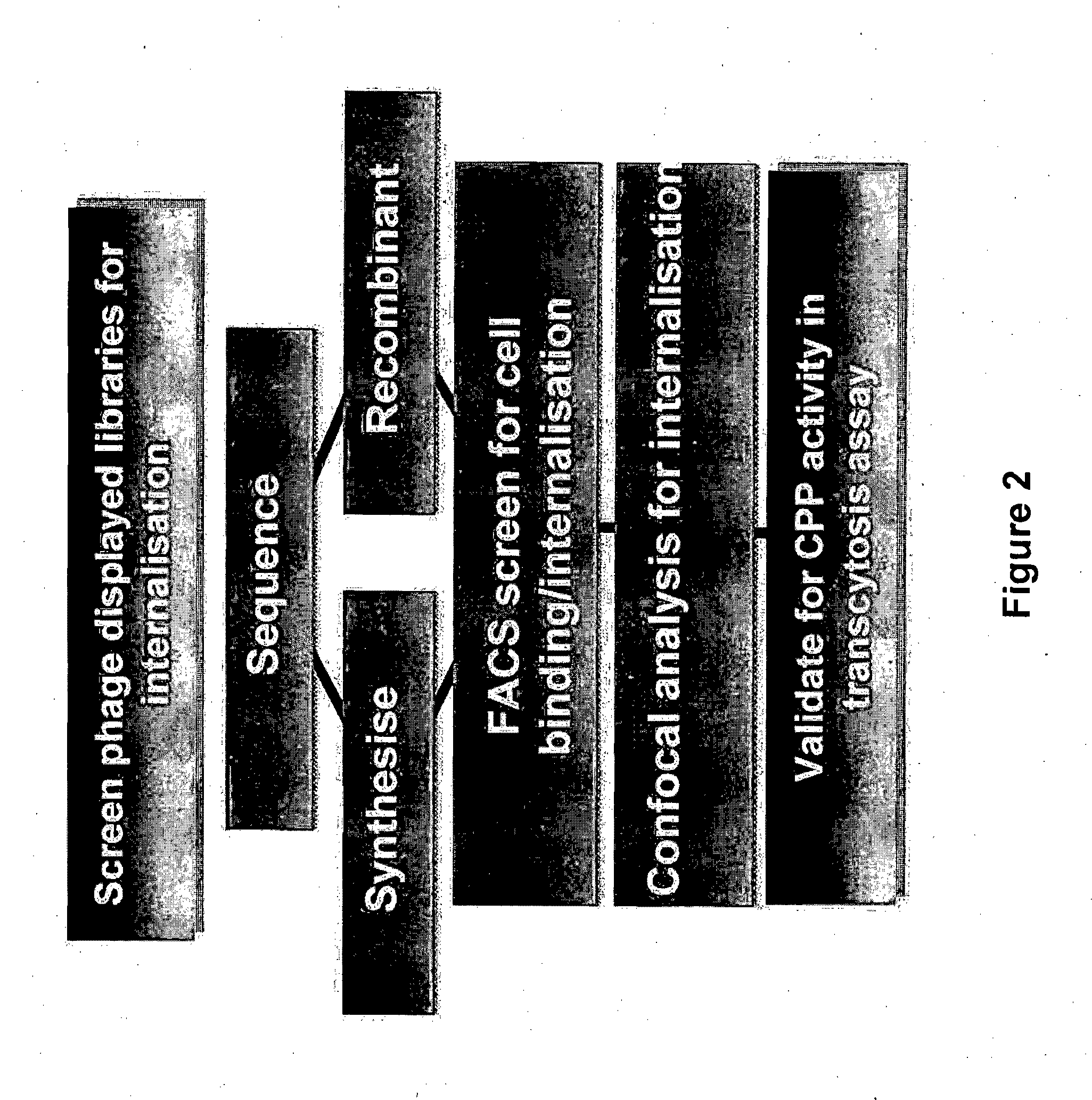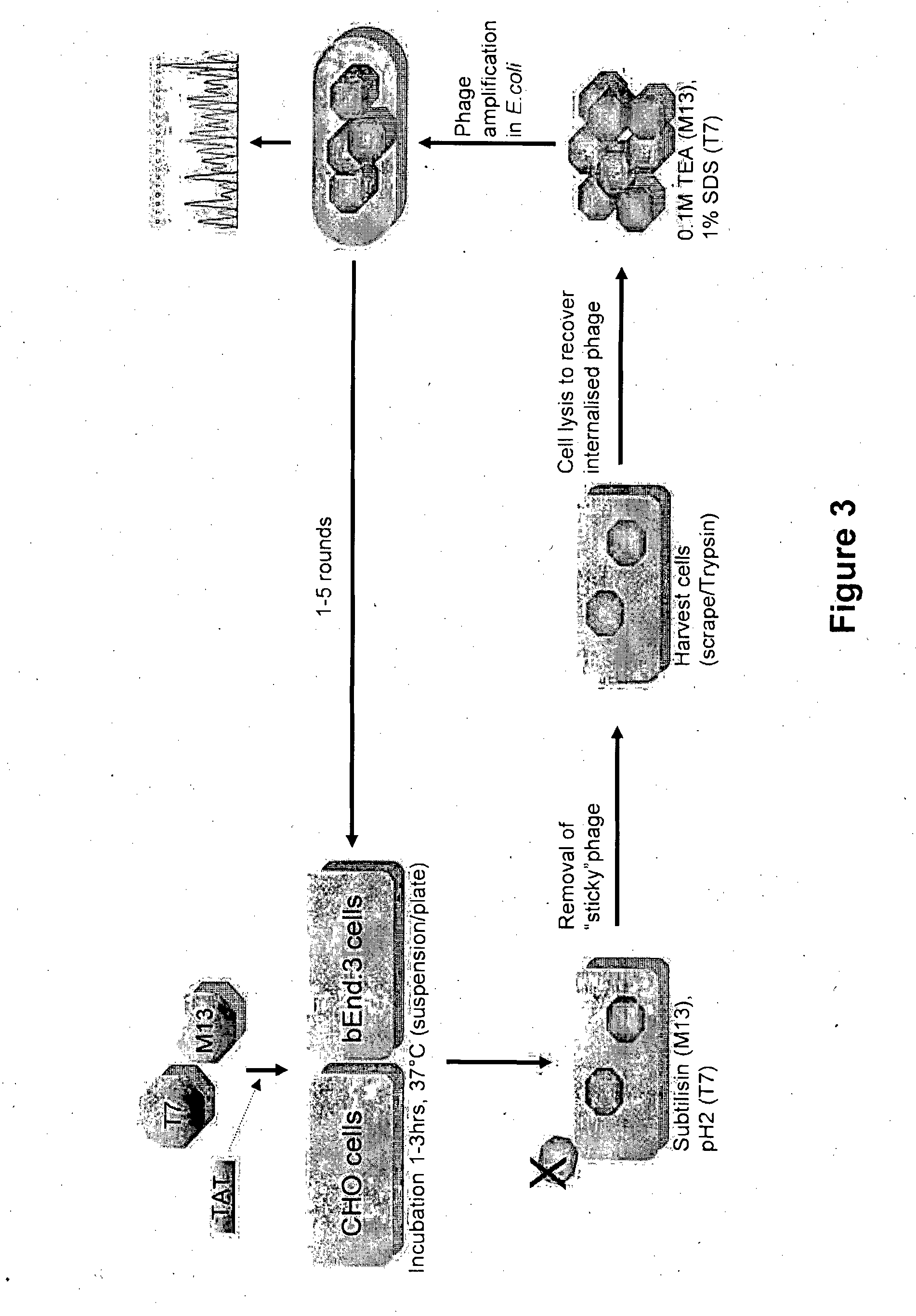Method of Determining, Identifying or Isolating Cell-Penetrating Peptides
a cell-penetrating peptide and cell-penetrating technology, applied in the field of pharmaceutical sciences, can solve the problems of limiting clinical application, cpps for drug cargo delivery is their non-selectivity, and lack of similarity, so as to maximize or optimise the survival of different cell types, reduce dilution effects and/or surface denaturation
- Summary
- Abstract
- Description
- Claims
- Application Information
AI Technical Summary
Benefits of technology
Problems solved by technology
Method used
Image
Examples
example 1
Materials and Methods
Lyophilized Dye Stock for Labeling of Phage
[0433]Dye is solubilized in anhydrous DMSO at 5 mg / mL, and stored at −20° C. with desiccant. Frozen dye aliquots are thawed slowly to room temperature (to prevent condensation)
Preparation of Phage for Labeling
[0434]Phage are purified by two PEG precipitations, resuspended in PBS, filtered through a 0.2 μM syringe filter, and cfu / mL or pfu / mL determined. Phage are concentrated by a further PEG precipitation and resuspended in labeling buffer (50 mM sodium tetraborate / 40 mM NaCl, pH 9.1 (M13) or PBS (T7)). Phage should be prepared ‘fresh’ (label one day after preparation). Once phage resuspended in labeling buffer, they should undergo the labeling reaction within 1-2 hours.
Labeling Reaction
[0435]For consistent level of labeling, about 200 molecules of dye per phage the following quantities were used:[0436]4×1012 phage particles (in 50-100 μL volume)[0437]10 μL of 5 mg / mL dye solution (=50 μg)
[0438]Phage and dyes solution ...
example 2
Cell Penetration Assays
Positive Cell-Penetrating Peptide (CPP) Control
[0463]A sequence previously reported to facilitate internalization into cells was chosen as a positive CPP control. RGD integrin-binding peptide was recovered from a whole-cell phage internalization screen. The positive control sequences were cloned into both M13 and T7 phage display vectors.
[0464]The CPP control sequence was successfully cloned into five different M13 phagemid display vectors (pNp8cys, pNp8, pNp3cys, pNp3, pJufop3_v2) and the T7 phage genome (Select10-3B). The integrity of all clones was confirmed via sequencing.
Phage Display of CPP Control
[0465]The efficiency of CPP display on the surface of phage was determined by ELISA. High display levels were observed for the RGD peptide, regardless of the vector system used. The RGD peptide displayed well in all vector systems and had previously been shown to facilitate internalization of phage into mammalian cells.
Labeling of Phage with Fluorophores
[0466]P...
example 3
Validation of Internalisation Capability of CPPs
[0497]A selection of 152 peptides from the screens were also synthesized with N-terminal FITC labels. Peptides (n=52) were also produced in Pepset format. For a positive CPP control, the inventors chose a TAT-PYC38 phage display fusion, which has previously been validated for CPP activity in mammalian cells using confocal microscopy and various other functional assays. PYC38 (+ / −TAT) peptides, along with the CPP controls listed in Table 1, were synthesized with N-terminal AF488- or FITC-fluorophores (Table 8).
[0498]Cells were seeded in 6-well plates and then grown for 24 hours before peptide was added for 1 hour at 37° C. Cells were harvested via trypsinization, and then assayed for peptide internalization / binding by flow cytometry.
[0499]The flow cytometry procedure was initially optimized using fluorophore-labelled TAT-PYC38. Subsequently, FITC-labelled peptides from the Phase 1-Pilot and Phase 2-CPP screens were assessed at 10 μM con...
PUM
| Property | Measurement | Unit |
|---|---|---|
| pH | aaaaa | aaaaa |
| pH | aaaaa | aaaaa |
| thickness | aaaaa | aaaaa |
Abstract
Description
Claims
Application Information
 Login to View More
Login to View More - R&D
- Intellectual Property
- Life Sciences
- Materials
- Tech Scout
- Unparalleled Data Quality
- Higher Quality Content
- 60% Fewer Hallucinations
Browse by: Latest US Patents, China's latest patents, Technical Efficacy Thesaurus, Application Domain, Technology Topic, Popular Technical Reports.
© 2025 PatSnap. All rights reserved.Legal|Privacy policy|Modern Slavery Act Transparency Statement|Sitemap|About US| Contact US: help@patsnap.com



